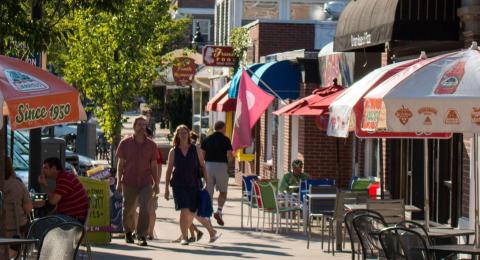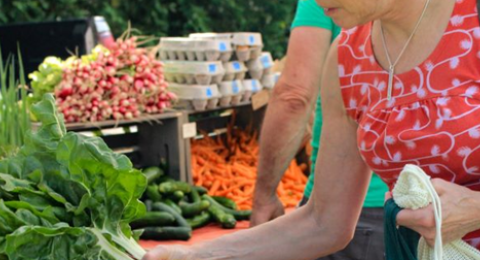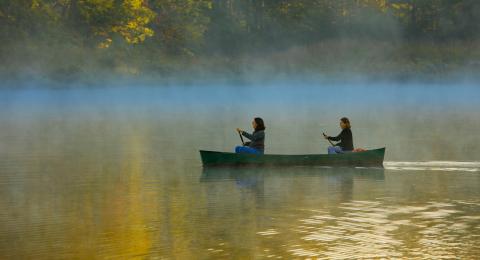Community vibrancy refers to the overall health, vitality, and resilience of a community, encompassing factors such as social connections, economic opportunities, cultural richness, and environmental sustainability. We’ve outlined 10 components of vibrant communities and statements to consider when thinking of the vibrancy of your community.
The 10 components of vibrant communities are adopted from resources from the National Civic League, are influenced by needs assessments conducted in New Hampshire communities, and are closely related to chapters in a community Master Plan.
1. Economic Vitality
A vibrant community includes access to a variety of environmentally friendly businesses, industries, and institutions that provide reasonable wages and benefits to workers, engage in family-friendly policies, provide workers with opportunities to develop marketable skills, and contribute to the overall well-being of the community.
Statements to consider:
- We have a diverse economic base. A variety of businesses, industries, and institutions make up the economic base of the community and the region. No one sector or one employer is dominant.
- Local government works well with the local businesses to enhance the economic vitality of the community.
- Main Street, downtown business and commercial areas are known and supported. Local businesses are patronized by community members and are highly valued.
- There are locally available educational opportunities to provide residents with skills that match the needs of local businesses.
- There are many types of jobs available to residents in terms of security, wage levels, skill levels, and benefits.
- Local wages allow the majority of the population to enjoy a reasonable lifestyle.
- The community’s zoning and planning rules are updated regularly and reflect a broad spectrum of residents’ vision of the community in 5, 10, and 20 years.
- There are opportunities and support for beginning entrepreneurs, such as a business incubator space or program at a local community college.
- There is an adequate built environment and structures to support economic development such as commercial space, industrial parks, food hubs and locations for production, distribution and warehousing.
2. Education and Lifelong Learning
Education is a lifelong endeavor, and much more extensive than just the K- 12 school system. Lifelong learning starts at home, continues through childhood and the teen years, and progresses throughout adult life.
People of all ages need to develop new knowledge and skills in order to improve the quality of their own lives and those of their families, and to contribute more effectively to community life.
Lifelong learning allows citizens to respond to a changing economy and participate in increasingly complex community issues with greater knowledge and skill.
Statements to consider:
- Education and training opportunities are high quality, easily accessible, affordable and provided equitably.
- Education and training opportunities, including formal and informal academic, vocational, artistic, and spiritual, meet the community's needs.
- School planning is evidence based and open to local and regional solutions; school planning engages the community and includes input from community members.
- There is a deep pool of skilled labor for local employers to draw from.
- The level and quality of adult literacy programming in the community reflect the needs of community members.
- Public school facilities adequately meet the needs of students and community members.
- Early childhood education and daycare options in the community are high quality, affordable and meet the needs of all families and their children.
- There is good communication and cooperation between municipal government, local public school board, local employers, and the larger community.
- The community supports and values high quality K-12 public school education.
- There is a support network for community members who home-school their children.
- The community is connected to a local community college, four-year college or university.
- Schools and other education and training opportunities accommodate the needs of a diverse citizenry in terms of race, culture, ethnic group, disability, age, gender, and sexual orientation.
3. Healthy Living and Wellness
The overall wellness of a community is a reflection of the physical, social and emotional health of its citizens. Individuals, families and communities must have the knowledge that enables them to make good decisions with regard to their health and well-being. Health and well-being encompasses access to health care, as well as preventative measures such as healthy eating and active living.
Most communities face a variety of challenging social issues, such as substance abuse, domestic abuse, poverty, obesity, and other concerns related to the elderly, youth, and families. Addressing these concerns effectively takes the coordinated efforts of the public, private, and nonprofit sectors.
Statements to consider:
- Generally speaking, the community is a healthy place to grow up and raise children.
- There is adequate access to healthy food options, including fresh fruits and vegetables for all within a reasonable distance.
- There are recreational opportunities available to encourage active living for residents of all ages and abilities.
- There are community efforts to address the issues of our youth, teens, seniors, parents, and families.
- All community members have access to a range of health services. Access includes consideration of both geographic and financial barriers.
- There is adequate information about the available services and many community members utilize them.
- Community services are “cradle to grave”, addressing the entire age spectrum of the community.
- The community is safe for community members to walk or bike.
- Local government and community organizations are responsive to the emerging needs of community members.
4. History and Culture
Arts, historical, and cultural activities are the soul of a community – arts, history, music, dance, theater, holidays, festivals and celebrations. These formal and informal community activities and events create community vibrancy. Cultural activities reflect and build a community's positive sense of itself and strengthen the fabric of social interactions within the community.
Statements to consider:
- Our community celebrates itself in many different ways.
- There are special cultural centers, events and festivals within the community. These events are well known within and outside the community.
- Our cultural events bring together and celebrate the community’s diverse population.
- The community preserves and enhances what is special and unique about its cultural heritage.
- Children, youth, and seniors are encouraged to participate in cultural events.
- Citizens are part of larger regional cultural events.
- There is an active Arts Council that promotes, cultivates and sustains art in the community.
- Our community houses a museum, historical sites, theatre, or other cultural attractions that serve local community members and draws visitors and tourists.
- The historic areas of our community are maintained, well known and respected.
- Youth and new community members are encouraged to learn about community history, historic areas and properties.
- Public art is encouraged, respected and maintained.
5. Housing , Neighborhoods and Community Spaces
The quality and availability of housing, neighborhoods, and community spaces is an important factor in a vibrant community. Housing encompasses the availability, affordability, and location of homes for sale and for rent. This directly affects the lives of community members, especially the elderly, disabled, and low-income families. In a vibrant community, neighborhoods are welcoming and safe, and a variety of public spaces are available for the community to gather.
Statements to consider:
- There is adequate and affordable housing for the elderly, disabled, local workforce, young families and/or single-parent families.
- There is adequate rental housing in the community.
- Neighborhood character is respected, and neighborhoods are welcoming and safe.
- Current zoning regulations consider protecting the character of key sections of the community when considering new commercial development.
- Zoning regulations are designed to counteract sprawl.
- Municipal government works well with landowners to consider the importance of natural resources and land features while respecting private property rights.
- Residential housing is planned so that negative effects on traffic, public schools, sewer and water systems, and wildlife habitats are minimized.
- There are indoor and outdoor spaces for the community to gather to connect, play, share, communicate, be creative and simply enjoy.
- Public spaces in schools, libraries and local government buildings are readily made available to community residents as welcoming spaces to meet.
- Neighborhood identity is supported and celebrated.
6. Leadership and Community Engagement
Healthy communities have and develop public leaders who work together to enhance the long-term future of the community. Community leadership must be responsive, honest, efficient, enlightened, fair and accountable. It should have the ability to bring the community together to participate in open, neutral dialogue on important issues. In a vibrant community, citizens actively participate through voting in local elections, serving on local boards, attending public hearings, and being involved in civic organizations and community activities.
Statements to consider:
- Leadership represents diverse community interests (age and gender groups, new and long-time residents, culture, etc.).
- Community leadership demonstrates knowledge, accountability, professionalism, innovation, and is results-oriented.
- Our leadership actively recruits, trains, and empowers new leaders. Citizens volunteer to serve on local boards and committees.
- Leaders involve local citizens in identifying community goals and resolving community issues.
- Leadership seeks out opportunities to exchange information with citizens about community issues.
- Community leadership and citizen participation is proactive, dealing with community issues before they become crises.
- Leaders demonstrate long range (20+ years) thinking. They understand the impacts of their actions on the long term health and vitality of the community.
- Leaders are willing to consider and use creative methods for addressing challenges, and look for regional solutions where appropriate.
- Citizens know how the system works and it is easy for newcomers to learn how to get involved in the community.
- Citizens have the information they need to make good decisions.
- Local committees and boards communicate well with each other, the public, and with boards and committees throughout the region.
7. Natural Resources , Climate and Energy
Natural resources contribute significantly to quality of life and community character. Natural resources include streams, rivers, walking trails, working farms, forests, clean air, wildlife, and undeveloped land. Climate change and energy usage are major stressors on natural resources. A vibrant community recognizes the importance of protecting their natural resources through plans, projects, and practices.
Statements to consider:
- Our community recently conducted a natural resource inventory. This may include an updated record of conservation lands and open space, wetlands, as well as rare plant and animal species.
- There is broad community interest and participation in protecting key natural resources.
- Steps have been taken for long-term land protection to assure functioning natural resources.
- Businesses in our community use environmentally friendly practices, such as water and energy efficiency.
- Our community has been recently impacted by extreme weather. We need solutions that enable us to better return to normal operations or become more “resilient” to these disturbances.
- Our community considers climate change impacts in short- and long-term planning (e.g., changing flood plains, water availability, siting infrastructure, etc.).
- Natural resources play an important role in our community’s economy.
- Our community protects natural resources at the watershed scale or across town boundaries.
- Our community protects the land around waterways (i.e., there is a “riparian buffer” ordinance or regulation to reduce development at the water’s edge).
- Our community reduces urban sprawl via mixed-use development - combining two or more types of compatible land uses, such as apartments and businesses, in the same building or in close proximity.
8. Recreation
Parks and recreational activities enhance the quality of life for residents and contribute to creating healthy, safe neighborhoods. Recreational activities include individual and team sports, outdoor activities, trails, and community facilities such as recreation centers, swimming pools, public parks, basketball and tennis courts, and athletic fields. Through recreation programs, community members improve their health and wellness, learn to compete and cooperate, build relationships, and become more involved in community life.
Statements to consider:
- There is a wide array of recreational activities and facilities available to all community members.
- Recreational opportunities are widely promoted and there is a high level of awareness of these opportunities.
- There are a variety of year-round recreational opportunities.
- Recreational facilities are appropriately and efficiently maintained for community members to enjoy.
- Recreational opportunities are designed and provided for community members of all abilities, ages and socioeconomic status.
- Trails connect parks, schools and other areas providing safe biking and walking.
- There are a variety of parks, including: pocket parks found at intersections or small spaces; parks with playground equipment for children; neighborhood parks; public parks focused on meeting community needs; school parks and athletic fields.
- Recreational opportunities allow community members to experience and appreciate the diversity of natural resources.
9. Sense of Community
A sense of community is an intangible yet vital component of a vibrant community. It encompasses elements such as image, spirit, character and pride, along with processes such as communication, inter-group relations, and networking. A community is made up of different people with different interests, experiences and backgrounds. These characteristics may divide a community into natural groups but there must be cooperation among them if the community is to work well as a unit. Increased communication and understanding of different perspectives among groups and within the community as a whole is an important factor in establishing a sense of community.
Statements to consider:
- There is adequate communication among diverse groups in the community such as natives/newcomers, summer/year round residents, young parents/retirees, as well as business community, commuters, etc.
- Residents have a strong sense of pride in their neighborhoods and community.
- The community recognizes and celebrates its diversity and inclusiveness (e.g., age, ethnicity, race, gender, culture, religion, income level, abilities and sexual orientation and expression).
- Groups are involved in identifying community goals and in resolving community issues.
- The community’s heritage is celebrated regularly.
- People can find out easily what is going on in the community. All groups know how to become involved in the community.
- Formal and informal forums exist for sharing ideas and resolving public issues.
- There is a common vision for our community among members.
- Community members often put aside their differences to work for the common good of the community.
- The self-image of the community is a positive one.
- Community members are proud of the community’s character.
10. Utilities, Facilities, Transportation and Internet
In order for a community to function, it must have essential facilities, services and utilities – public facilities such as municipal buildings, schools, sidewalks, roads, libraries, a recycling center, and cemeteries; services and utilities such as police, fire, ambulance, highway maintenance, water and sewer. These key functions consume the majority of tax dollars and sharply influence the community’s quality of life. Broadband Internet is a service that is an important part of modern life. High- speed internet connects community members to resources, and is also crucial for economic development.
Statements to consider:
- Public facilities and services are needed and valued in our community.
- The community’s road system is adequate and well-maintained. The use of traffic controls (e.g., signs, lights, speed limits, police, etc.) is well-planned and coordinated.
- Our public water sources are protected.
- Our community does a great job of reducing, recycling and handling disposal of its wastes.
- The town has a plan for financing the maintenance, expansion and replacement of its public facilities.
- The community is open to regional solutions for future infrastructural needs.
- Public buildings such as schools and town offices are adequate for our needs.
- Our public buildings are accessible to people with disabilities and are energy efficient.
- Officials address qualitative concerns about facilities and systems and utilize alternative methods of service delivery.
- Appropriate physical connections exist, such as public transportation between housing and job sites.
- There are appropriate levels and quality of emergency services - fire, police, and ambulance.
- Streets are designed and operated to enable safe access for all users, including pedestrians, bicyclists, and motorists of all ages and abilities.
- Parking is adequate in commercial areas.
- High-speed internet is accessible and affordable to all community members ideally at home but also at school, library, town hall and local businesses.
The 10 components of vibrant communities are adopted from the National Civic League, influenced by needs assessments conducted in New Hampshire communities, and closely relate to chapters in a Master Plan.


